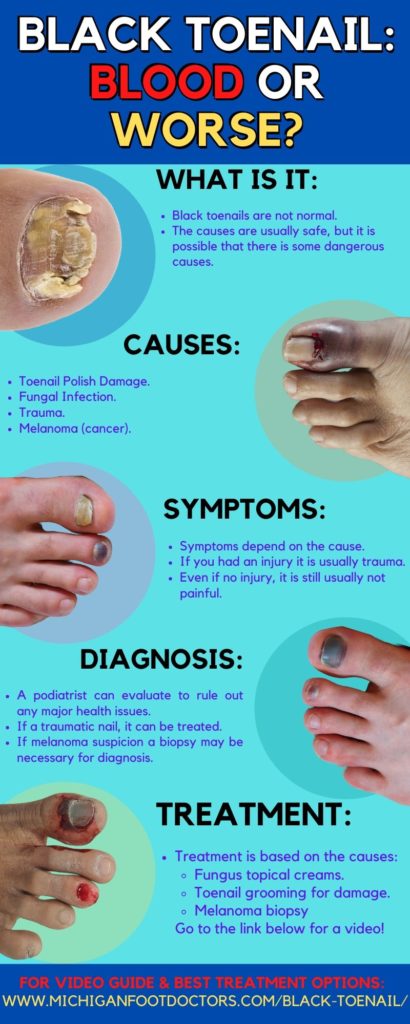Toenail Pain (Toenail Fungus, Ingrown Toenails, Discolored Toenails)
Foot Toe and Toenail Cancer [Causes, Symptoms & Best Treatment]
Foot, toe and toenail cancer is not very common in the foot. The most dangerous is #1)malignant melanoma & #2) most dangerous is a squamous cell carcinoma.

Red or Black Toenail Picture & Photo Gallery:
Look:
- A red toenail generally means fresh blood or a fresh injury.
- This can be called a toenail hematoma or fresh blood from repetitive irritation.
- A black toenail is generally more dried blood that has crested underneath the toenail.
- Very infrequently, can a black toenail be something more dangerous like melanoma?
- It is also possible for your toenail to the infected with toenail fungus. This can also then result in rubbing and bleeding after the toenail fungus.
- If there is toenail fungus, this is usually more of a brown or yellow color.
- A toenail falling off is a widespread problem as well.
Please click on the photo gallery for descriptions & full-size photos!
Foot, toe and toenail cancer is not very common in the foot:
- Foot, toe and toenail cancer is not very common in the foot.
- The most dangerous type is a #1 )malignant melanoma.
- The second #2) most dangerous is a squamous cell carcinoma.
- The least dangerous cancer of the foot is a #3)basal cell carcinoma of the foot.
- These types of cancers are outlined and the treatments are shown below.
- It is important to check with your podiatrist if you suspect this!
Most Dangerous to Least Dangerous Foot, Toe and Toenail Cancers:
1)Malignant Melanoma of the Foot:
- Malignant melanoma of is one of the most dangerous skin cancers known. This certainly is the most dangerous foot, toe and toenail cancer that you can have.
- This type of cancer usually does need to be biopsed very quickly as the earlier you find it, the quicker you will be able to get better.
- This is not one you want to wait around with. If you do delay, survival is very low.
- Surgery is usually needed as the treatment of choice for this cancer. Non-surgical treatments are usually not very effective.
- This type of cancer does occur in the foot, toe and toenail. Yet, overall this type of cancer is rare in the foot. Almost every time that it does look like a plaque or black spot under the toenail, then it is usually not.
- As the melanoma grows deeper into the skin and into the blood vessels, this is when it is considered malignant.
Symptoms of a Melanoma in the foot, toe and toenail:
- This is usually called “The great masquerader”.
- It usually appears as a small brown or black spot or bump. But 1/3rd of them can lack any pigment at all. They can even occassionally appear pink or red.
- These do usually appear as “moles”
- In the toenail, melanomas may resembled moles, blood blisters, ingrown toenails with bleeding, wart like lesions, or even a bruise.
- Consider the ABCDE: Asymmetry, border, color, diameter and elevation changes can lead to further issues.
- Asymmetry – If the lesion is divided in half, the sides don’t match.
- Borders – Borders look scalloped, uneven, or ragged.
- Color – There may be more than one color. These colors may have an uneven distribution.
- Diameter – The lesion is wider than a pencil eraser (greater than 6 mm).
- To detect other types of skin cancer, look for spontaneous ulcers and non-healing sores, bumps that crack or bleed, nodules with rolled or “donut-shaped” edges, or scaly areas.
2)Squamous Cell Carcinoma of the Foot:
- This is the most common type, but not the most dangerous type of skin cancer of the foot, toe and ankle.
- This type of cancer usually does not spread deep, except when allowed to progress for a long time.
- When these do become advanced, they can spread through the body.
Symptoms of a Squamous Cell Carcinoma in the foot, toe and toenail:
- This usually b geins as a small scaly bump or a plaque. This may appear swollen and irritated.
- This can also look like a hard callus or a bump. It can also look like a wart, eczema or an ulcer.
- It is usually painless, it may itch.
Basal Cell Carcinoma of the Foot:
- This is usually in an area that is exposed to the sunlight. This is mostly on superficial skin surfaces.
- If it is usually in covered skin, this is unlikely to take place.
- This is rarely a dnagerous type of skin cancer. It rarely spreads.
Symptoms of a BasalCell Carcinoma in the foot, toe and toenail:
- These usually are white bumps or patches. They can also be black.
- They may ooze, crust or look like an open sore.
- These usually look like tumors or benign ulcers.
Diagnosis:
- If you are concerned about a dangerous growth on your foot, toe or toenail don’t wait!
- Go see your podiatrist or family doctor immediately.
- A biopsy may need to be performed.
Big Toe Joint, Hammer Toe & Bunionette Problems
